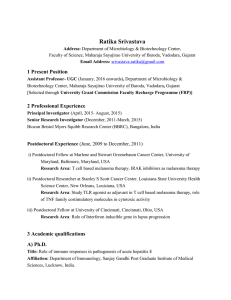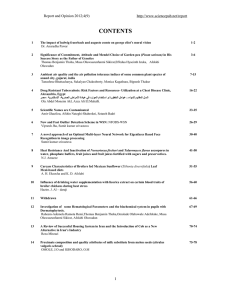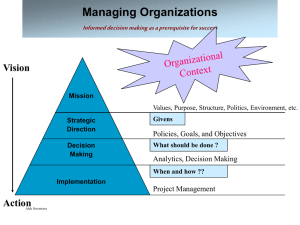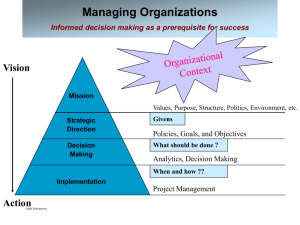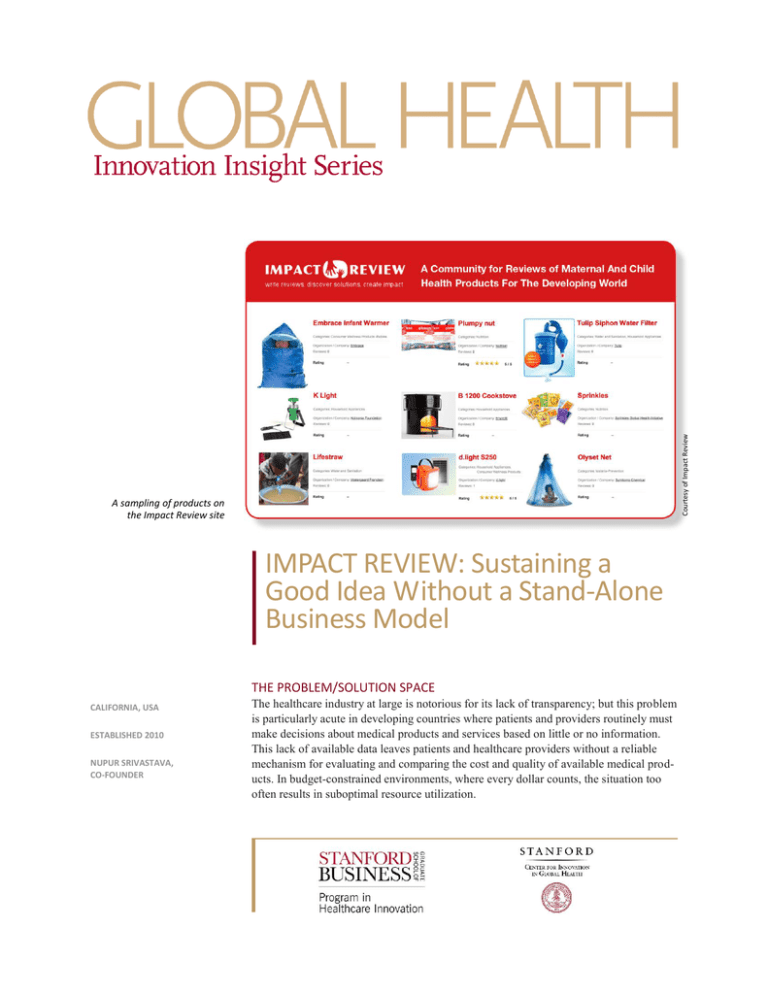
Courtesy of Impact Review
A sampling of products on
the Impact Review site
IMPACT REVIEW: Sustaining a
Good Idea Without a Stand-Alone
Business Model
THE PROBLEM/SOLUTION SPACE
CALIFORNIA, USA
ESTABLISHED 2010
NUPUR SRIVASTAVA,
CO-FOUNDER
The healthcare industry at large is notorious for its lack of transparency; but this problem
is particularly acute in developing countries where patients and providers routinely must
make decisions about medical products and services based on little or no information.
This lack of available data leaves patients and healthcare providers without a reliable
mechanism for evaluating and comparing the cost and quality of available medical products. In budget-constrained environments, where every dollar counts, the situation too
often results in suboptimal resource utilization.
ABOUT IMPACT REVIEW
Mid-way through an MBA program at the Stanford Graduate School of Business (GSB),
Nupur Srivastava completed an internship in India for D-Rev (Design Revolution)—a
nonprofit technology company whose mission is to improve the health and incomes of
people living on less than $4 per day. 1 While investigating the market for a high-quality,
low-cost medical product in the infant care space, Srivastava became aware of the information gap faced by healthcare providers and their patients. The market was crowded
with competing products, which varied dramatically in their price and quality. Yet, users
had no way to effectively evaluate one option against another. “They would take everything at face value,” she recalled. “When you said something, they would believe it. And
it was really frustrating because there was no good way to help them save money by
directing them to less expensive, higher-quality products.”2
Srivastava’s classmate, Robyn Calder, discovered the same dilemma while interning for the Clinton Health Access Initiative in
Ethiopia. After witnessing the failure of kerosene-based refrigerators (due to kerosene stock-outs) that were used to maintain the
potency of vaccines in rural health centers, she began researching
solar refrigerator options. However, she had no way to recognize
the differences in product value based on the limited information
available to her.
Courtesy of Impact Review
When Srivastava and Calder returned to the GSB, they both enrolled in a project-based course called Evaluating Entrepreneurial
Opportunities. Along with two other colleagues, David Chanin
and Rosa Wu, they discussed the lack of product and service
information available in developing countries. The four of them
were passionate about healthcare and felt particularly troubled by
the effects of this problem on stakeholders in this field. They
started to research the situation as a potential class project. Further investigation confirmed that no portals existed where patients
and healthcare workers could efficiently and reliably gather product/service information, voice concerns, or make endorsements
based on their experiences.
The Impact Review team
Working as a team, they set out to create a platform for developing-world healthcare providers that would facilitate improved
information sharing about high-impact, affordable solutions in the
maternal and infant health space.3 The result was Impact Review, an online knowledgebase with a user rating system to aid the target audience in making more informed purchasing decisions based on user-generated commentary.
Impact Review’s online community allowed users to search or browse (by product category) for relevant product information. They could narrow their results by sorting products into subcategories such as “Recently Added,” “Most Reviewed,” or “Highest Rated.” Visitors to Impact Review were also encouraged to add products and write reviews
based on their field experience with specific solutions to help expand the knowledgebase. Similar to Yelp (which the team used as a benchmark), the rating system was designed to be simple and democratic, with just one score and one comment per person. To
ensure credibility, contributors were required to log in with their name and organization.
IMPACT REVIEW: SUSTAINING A GOOD IDEA WITHOUT A STAND-ALONE BUSINESS MODEL
AUGUST 2012
2
With the databases constantly growing and changing, the team hoped that visitors would
use it to search for information about known products, but also to discover new products
that could have an impact in their environments.
Once the site was up and running, Srivastava
and her teammates reached out to personal
contacts within the target audience to test the
site and write a set of initial reviews. Healthcare
providers in rural areas in India and other developing countries contributed, and Impact Review
was launched with 25 product reviews just as
the team prepared to graduate from the GSB. “It
was slightly bare bones, so after we graduated
we spent more time fine-tuning the site through
several iterations,” Srivastava said. Overall, the
portal elicited positive feedback from its preliminary users.
ONE CHALLENGE: SUSTAINING A GOOD
IDEA WITHOUT A STAND-ALONE
BUSINESS MODEL
Courtesy of Impact Review
When Srivastava, Calder, Chanin, and Wu left
the GSB, they had to determine what was next
for Impact Review. The team considered whether Impact Review could become a sustainable
(although socially-minded) business. The primary model they explored was to generate revenue
by posting advertisements on the site. However,
in order to appeal to advertisers, the site would
need to generate a high volume of regular traffic. Attracting and retaining such a large number
of visitors during the company’s early stages did
not seem feasible. It was also unclear exactly
what types of advertisers would be drawn to
Impact Review, and whether those organizations
would have adequate funding to purchase ad
space on a continual basis.
Screen shots from the
Impact Review site
The team members contemplated the idea of
establishing Impact Review as a nonprofit and
using donations to underwrite the organization’s
ongoing operations. However, because all four
teammates had accepted full-time jobs upon
graduation, they worried about their ability to
raise adequate contributions over the long term.
Up until this point, the team had not relied on any external funding. “We supported it
ourselves,” Srivastava noted.
IMPACT REVIEW: SUSTAINING A GOOD IDEA WITHOUT A STAND-ALONE BUSINESS MODEL
AUGUST 2012
3
Another option was to find one or more established entities that could benefit from Impact Review’s technology and get them interested in acquiring the technology. Not only
would this ensure that the mission of Impact Review was carried forward, but it could
help the platform take a giant leap forward if it was acquired by a company with a large
established base of users in the target market. Although it did not have any immediate
leads for potential acquirers, the team felt certain that others would understand the value
of filling the information gap in the global maternal and infant health field.
THE SOLUTION: IDENTIFYING THE BEST FIT FOR AN ACQUISITION
After further evaluation of for-profit and nonprofit business models, the Impact Review
team became convinced that it should seek an acquisition of its technology. “Nobody on
the team could take on Impact Review as a full-time job,” recalled Srivastava, “but we
were very committed to making sure that our effort found a home where it could actually
reach a wide user base.” The key was to identify a partner that would appreciate and
sustain the Impact Review mission.
The first step was to figure out who might be interested in acquiring the site. The team
conducted extensive online research to identify a shortlist of potential targets. They also
tapped into their personal networks for ideas about (and introductions to) individuals and
groups that might realize synergies by incorporating the technology into their existing offerings. While investigating leads in
their network, Krista Donaldson, CEO of D-Rev, introduced the
team to several candidates. Among them was Meg Wirth, foundNobody on the team could take on
er of Maternova, Inc.—a women-owned start-up focused on
Impact Review as a full-time job, but
solutions for reducing maternal and infant mortality in the developing world.4 Maternova had created a first-of-its-kind marwe were very committed to making
ketplace for ideas and technologies that could save mothers and
newborns in low-resource settings.5 The company described
sure that our effort found a home …
itself as a mission-driven for-profit. “Because Maternova was
similar to us in their passion for maternal and infant health, we
felt it was a perfect match,” Srivastava explained. “They already had a large user base
and many products on their site. The component that was clearly missing on the Maternova website was the rating piece.”
As a next step, the team engaged Wirth in a dialog about Impact Review and the benefits
that its technology could offer to Maternova. In particular, they discussed how user
reviews could enhance Maternova’s Innovation Index, which tracked relevant products
through the inception phase to market.6
Recognizing that its model would add value to Maternova but not help the company
directly generate revenue, the Impact Review team worked collaboratively with Maternova to reach an agreement that suited both parties. The team’s primary concern was to
ensure the technology would be used in a credible and transparent manner to benefit its
intended audience. As part of the agreement, Srivastava also took a seat on Maternova’s
board to help integrate and guide the expansion of Impact Review’s technology, as well
as to advise Maternova on its future direction.
Looking back on her experience, Srivastava acknowledged that sometimes a good idea
that addresses an important unmet need cannot support a stand-alone business plan,
IMPACT REVIEW: SUSTAINING A GOOD IDEA WITHOUT A STAND-ALONE BUSINESS MODEL
AUGUST 2012
4
particularly in global health. In these cases, teams must get creative if they want the idea
to flourish. “The most important thing was to make sure Impact Review was carried
forward,” she commented. “Through the Maternova deal, I’m confident we’ll make a
real difference.”
NOTES
1
About, D-Rev, http://d-rev.org/about.html (September 4, 2012).
2
All quotations are from an interview with Nupur Srivastava conducted by the authors, unless otherwise
cited.
3
About, Impact Review, http://www.impactreview.org/about (September 4, 2012).
4
“Maternova Acquires Impact Review,” PBN.com, July 30, 2012, http://www.pbn.com/Maternova-acquiresImpact-Review,69394 (September 4, 2012).
5
About, Maternova, http://maternova.net/about-maternova (September 4, 2012).
6
“Maternova Acquires Impact Review,” op. cit.
This research was supported by the National Institutes of Health grant 1 RC4 TW008781-01.
Julie Manriquez and Lyn Denend prepared this vignette with Professor Stefanos Zenios as the basis for discussion rather than to illustrate either effective or ineffective handling of a management situation. Copyright ©
2012 by the Board of Trustees of the Leland Stanford Junior University. All rights reserved. No part of this
publication may be reproduced, stored in a retrieval system, used in a spreadsheet, or transmitted in any form
or by any means—electronic, mechanical, photocopying, recording, or otherwise—without the permission of
the Stanford Graduate School of Business.


